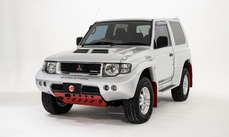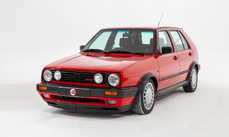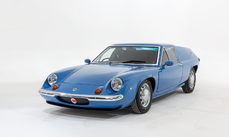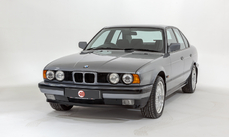Mitsubishi Pajero Evolution 1997
Allgemeine Beschreibung :
Model History
The Mitsubishi Pajero, known as the Shogun in the UK, is a Sport Utility Vehicle that first launched in 1982. With roots tracing back to the 1934 PX33 prototype, the first generation of Pajero was unveiled at the Tokyo Motor Show in 1981; the fourth generation is still in production today. Modified versions of the Pajero are noted for having won the Dakar Rally 15 times.
A redesigned second generation Pajero debuted in January 1991. Just about everything was new and further enhanced. It also saw the introduction of Super Select 4WD (SS4), multimode ABS, and electronic shock absorbers. SS4 was groundbreaking in the sense that it combined the advantages of part-time and full-time four-wheel drive with four available options: 2H (high-range rear-wheel drive), 4H (high-range full-time four-wheel drive), 4HLc (high-range four-wheel drive with locked centre differential) and 4LLc (low-range four-wheel drive with locked centre differential). Another advantage of this second generation system is that it gave the driver the ability to switch between two-wheel drive and full-time four-wheel drive at speeds up to 62 mph. Multimode ABS was equally innovative. This meant that the ABS would be fully functional in all modes of SS4, as braking with a locked centre differential requires completely different braking parameters.
The Pajero Evolution was introduced in October 1997 and was developed in response to new entry requirements for the Dakar Rally's T2 Class. The Evolution came standard with a 3.5-litre 24-valve DOHC V6 that featured Mitsubishi Innovative Valve Timing and Electronic Lift Control system (MIVEC). A new dual plenum variable intake helped increase power, and a new independent rear suspension made the ride even smoother. A grand total of 2,500 were manufactured for homologation purposes. They could be ordered in either Sofia White, Passion Red, or metallic Satellite Silver.
Mitsubishi not only dominated the T2 class with this car, they dominated the whole Dakar Rally. Paj-Evos took the top three spots in 1998, beating even the supposedly faster T3 class cars. They covered over 10,000km in 18 days, and finished five hours before the next competitor. Pajeros have won nearly half of all the Dakar Rallies with 15 wins overall.
Equipment
Satellite Silver Metallic paintwork, Recaro cloth upholstery, INVECS-II five-speed automatic transmission with Sports mode, Super Select 4WD system, Rear spoiler with side airdams, Aluminium skid plate, Jaos mud flaps, Four-wheel independent suspension (ARMIE), Privacy glass, Automatic air conditioning, Leather-trimmed steering wheel, Carbon-effect trim, Carbon shift knobs, Electrically adjustable door mirrors, Colour-coded door mirror casings, Passenger side wing mirror, ABS, Wind deflectors, Front SRS airbags, Sony CD player with Bluetooth, Spare wheel, Toolkit, Spare key.
Exterior
The Satellite Silver paintwork remains in great original condition, presenting well with only a handful of minor blemishes to report, the worst being some very light marks in one or two discreet areas. Elsewhere, commonly worn items such as the side steps retain a smart black sheen with no damage or fading to note. The Jaos competition-style mudflaps really add to the sense of occasion, and the rear privacy glass is a welcome addition. Genuine Mitsubishi wind deflectors are also fitted. Furthermore, having resided on the salt-free roads of Japan up until recently, both the body and underside of this rare Pajero remain in remarkable rust-free condition.
Interior
Equipped with attractive Recaro seats the interior of the PajEvo has a rugged but purposeful aesthetic. The seats are upholstered in hardwearing cloth that also extends to the door cards. The steering wheel is trimmed in leather and the dash fascia is finished with carbon-effect trim. The rear seats are also in very good order and boast individual folding armrests; the seats fold forward twice for a huge rear load space. The boot carpet is entirely unmarked and in the rear door you’ll still find the original toolkit.
ENGINE & TRANSMISSION
The Evo is powered by the 6G74 3.5-litre V6. The 24-valve DOHC engine features Mitsubishi’s Innovative Valve Timing and Electronic Lift Control, which varies the timing of the intake and exhaust camshafts to increase the power and torque output over a broad engine speed range.
The engine bay of this example maintains a particularly fresh appearance with no signs of any damage or poor repair. The car pulls well on test and shifts smoothly through each of the five gears. The Super Select 4WD system also operates just as it should, combining the advantages of part-time and full-time four-wheel drive with four additional drive options. The last service was carried out just a few hundred miles ago and following a recent inspection the car boasts a clean bill of health.
WHEELS, TYRES & BRAKES
The original six-spoke alloys have been freshly refurbished to an amazing standard by Lepsons. All five present with an impeccable diamond cut finish, as per original spec. The Mitsubishi centre caps are all present and correct and the wheels are shod in a matching set of rugged Bridgestone all-terrain tyres, really filling those vast box arches. On test the brakes operate well, pulling the Evo to a halt quickly and in a straight line.
History File
This example is one of just 2,500 Evolutions built to homologate Mitsubishi’s Dakar Rally T2-class Pajero. It was first registered in December 1997, remaining in Japan until its recent UK import last year. The car is accompanied by the original owner’s manual, maintenance booklet, and spare key. It has been serviced at the following mileages: 1k, 15k, 19k, 20k, 20k, 20k, and most recently at 34k miles. The car will be sold with 12 months MOT upon sale for the new keeper’s piece of mind.
http://www.4starclassics.com/for-sale/mitsubishi-pajero-evolution-for-sale-2/
1997 Mitsubishi Pajero Evolution is listed verkauft on ClassicDigest in Kingsley by 4 Star Classics for £18495.
Fakten der Auto
Karosserietyp : Auto Marke : Mitsubishi Modell : Pajero Ausführung : Evolution Hubraum : 3.5 Modelljahr : 1997 Karosstyp : Pick up Lage : Hampshire
Verkauft
Angaben Zum Verkäufer
Verkauft
People who viewed this Mitsubishi Pajero also viewed similar Mitsubishi listed at ClassicDigest
Other cars listed for sale by this dealer
über Mitsubishi
Mitsubishi: Eine Reise durch die Geschichte (bis in die 1980er Jahre)1. Frühe Anfänge:
Gründung: Mitsubishis Wurzeln reichen zurück zur Gründung einer Schifffahrtsfirma durch Yataro Iwasaki im Jahr 1870.
Diversifizierung: Das Unternehmen expandierte in den Bergbau, den Schiffbau und andere Branchen, was die Grundlage für die Mitsubishi Group bildete.
2. Erste Automobilunternehmungen:
Erste Automobilproduktion: Mitsubishi wagte sich im frühen 20. Jahrhundert in die Automobilproduktion.
Modell-A: Im Jahr 1917 führte Mitsubishi sein erstes Serienfahrzeug, das Modell-A, ein, Japans erstes Serienautomobil.
3. Nachkriegsära:
Umstrukturierung: Nach dem Zweiten Weltkrieg stand Mitsubishi vor Herausforderungen, durchlief jedoch eine Umstrukturierung und nahm die Automobilproduktion wieder auf.
Produktion von Jeeps: Anfangs konzentrierte sich Mitsubishi auf die Produktion von Jeeps und trug erheblich zur Wiederbelebung der japanischen Automobilindustrie bei.
4. Meilenstein-Modelle:
Mitsubishi 500: 1960 eingeführt, war der Mitsubishi 500 ein Kompaktfahrzeug, das dazu beitrug, kleinere Fahrzeuge in Japan populär zu machen.
Mitsubishi Colt 600: 1962 herausgebracht, war der Colt 600 ein Kleinwagen, der dazu beitrug, Mitsubishis Präsenz auf dem Automobilmarkt zu stärken.
5. Globale Expansion und die 1970er Jahre:
Partnerschaften: Mitsubishi schloss Partnerschaften mit internationalen Automobilherstellern und erweiterte damit seinen Einfluss über Japan hinaus.
Galant und Lancer: Modelle wie der Galant und der Lancer gewannen in den 1970er Jahren an Popularität und zeigten Mitsubishis Engagement für Innovation und Leistung.
6. Technologische Fortschritte:
Mitsubishi Astron-Motor: In den 1970er Jahren eingeführt, wurde der Astron-Motor zum Markenzeichen von Mitsubishi-Fahrzeugen und war bekannt für seine Langlebigkeit und Effizienz.
7. Höhepunkt der 1980er Jahre:
Mitsubishi Pajero: Anfang der 1980er Jahre eingeführt, markierte der Pajero (Montero in einigen Märkten) Mitsubishis Einstieg in das SUV-Segment und wurde ein globaler Erfolg.
Starion: Der Starion, Mitte der 1980er Jahre eingeführt, war ein Sportwagen, der Mitsubishis Leistungsfähigkeit demonstrierte.
8. Klassische Modelle von Mitsubishi der 1980er Jahre:
Mitsubishi Delica: Der Delica, erstmals in den 1960er Jahren eingeführt, gewann in den 1980er Jahren an Popularität und war ein vielseitiger Van in verschiedenen Konfigurationen.
Mitsubishi Mighty Max: Dieser kompakte Pickup-Truck war bekannt für seine Robustheit und Praktikabilität.
Mitsubishi Mirage: Der Mirage, in Hatchback- und Limousinen-Versionen erhältlich, wurde aufgrund seiner Kraftstoffeffizienz und Zuverlässigkeit beliebt.
Mitsubishis Reise durch die 1980er Jahre spiegelt ihre Entwicklung von einem vielfältigen Konglomerat zu einem bedeutenden Akteur in der globalen Automobilindustrie wider. Das Jahrzehnt brachte die Einführung von ikonischen Modellen mit sich, die Mitsubishis Ruf für Innovation und Leistung stärkten.








